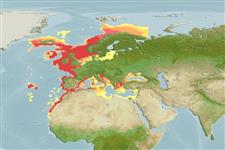Common names from other countries
Environment: milieu / climate zone / depth range / distribution range
Écologie
marin démersal; profondeur 18 - 1075 m (Ref. 58452), usually 70 - 400 m (Ref. 35388). Temperate; 76°N - 18°N, 30°W - 42°E (Ref. 58452)
Eastern Atlantic: Norway and Iceland, southward to Mauritania. Also in the Mediterranean Sea and along the southern coast of the Black Sea.
Length at first maturity / Taille / Poids / Âge
Maturity: Lm 42.3, range 20 - 70 cm
Max length : 140 cm TL mâle / non sexé; (Ref. 1371); common length : 45.0 cm TL mâle / non sexé; (Ref. 1371); poids max. publié: 15.0 kg (Ref. 1371); âge max. reporté: 20 années (Ref. 35388)
Épines dorsales (Total) : 0; Rayons mous dorsaux (Total) : 43 - 51; Rayons mous anaux: 36 - 40. Inside of mouth and branchial cavity black. Second dorsal and anal fins notched. First vertebra and neural spine attached to skull. Vertebrae 50-52.
Minimum depth from Ref. 128002. Found usually between 70 and 370 m depth. Adults live close to the bottom during day-time, but move off-bottom at night. Adults feed mainly on fish (small hakes, anchovies, pilchard, herrings, cod fishes, sardines and gadoid species) and squids. The young feed on crustaceans (especially euphausiids and amphipods). Are batch spawners (Ref. 51846). Almost entirely marketed fresh, whole or filleted, to specialized restaurants or retail markets (Ref. 58452). Utilized fresh, dried or salted and frozen; can be steamed, fried, microwaved and baked (Ref. 9988). Stocks seem to be over-fished (Ref. 35388).
Continuous recruitment of oocytes connotes indeterminate fecundity for this species (Ref. 79799).
Cohen, D.M., T. Inada, T. Iwamoto and N. Scialabba, 1990. FAO species catalogue. Vol. 10. Gadiform fishes of the world (Order Gadiformes). An annotated and illustrated catalogue of cods, hakes, grenadiers and other gadiform fishes known to date. FAO Fish. Synop. 125(10). Rome: FAO. 442 p. (Ref. 1371)
Statut dans la liste rouge de l'IUCN (Ref. 130435)
Warning: mysqli::__construct(): (HY000/1040): Too many connections in /var/www/html/includes/func_getlabel.php on line 46
Can't connect to MySQL database (fbapp). Errorcode: Too many connections
